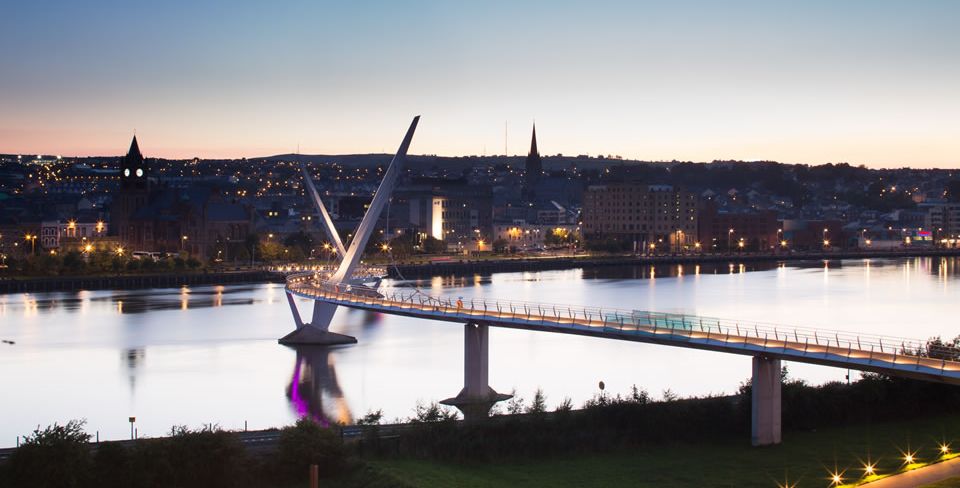
Derry
Derry is the only city on Slí Cholmcille. A monastery, founded here in the 6th century, sat high on the hill. Derry, from the Irish Doire, means ‘oak grove’, and in the first days of settlement here the hill was a wooded island surrounded by water and wetland. There are a few hints that the island was the location of a fort belonging to the local kings before it was handed over to the church.
There are few physical remains of the monastery above ground in the modern city, but it has shaped its history and left a wealth of stories. Many of the stories are found in the Life of Colmcille written in Irish in the Abbey of Derry in the 12th century. The 16th century Life of Colmcille, compiled by Manus O’Donnell, Prince of Tyrconnell, has an even larger compendium of stories, including stories from Derry, Donegal, the shores of Lough Foyle and places as far away as Lough Ness in Scotland. These stories have been part of the life of the city from medieval times to the present day.
Colmcille is said to have founded a monastery here in 545. According to the 12th century Life, it was his first and most beloved monastery. He is said to have left Derry in 562 for exile in Scotland where he founded the great monastery of Iona in 563. By the 12th century the city was known as Doire Cholmcille in dedication to the saint
The earliest written evidence, however, shows that the monastery of Derry was founded in the 6th century, by Fiachra mac Ciaráin, a cousin of Colmcille. Derry was part of the familia or family of monasteries associated with Colmcille. In the 12th century it became head of the Columban monasteries in Ireland, and its abbot was recognised as the Comharba Cholmcille or successor of the saint.
The trail in Derry is based on the route of a medieval pilgrimage. It starts at the Guildhall Square, once the harbour of Port na Long (the port of the ships), where pilgrims would have landed, and finishes at the Long Tower Church. In this area stood the Teampall Mór, or “Great Church”, near which Colmcille is said to have met Christ in the shape of a beggar.
Getting there
To follow the old pilgrim route, start at Guildhall Square, go through Magazine Gate below the Tower Museum, and up Magazine Street towards St Augustine’s Church. It is also possible to start your journey on the east bank of the Foyle, from Colmcille’s statue in St Columb’s Park, crossing the river via the Peace Bridge to arrive at Guildhall Square.
It takes at an hour to walk the old pilgrim trail from the Guildhall Square and return to where you started. It is worth leaving extra time to view the inside of St Augustine’s and the Long Tower Churches, to take a tour of the exhibitions at Áras Cholmcille, or to take a break in its coffee shop. A longer tour can include St Columb’s Cathedral and St Columb’s Wells.
Derry
- 4.1 Port na Long (Guild Hall Square)
In the medieval city, Guild Hall Square was Port na Long - ‘the port of the ships’ on the banks of the Foyle. This is was a main approach to medieval city. It was also the starting point of a medieval pilgrimage described by Manus O’Donnell in 1532, and is the start...
- 4.2 St Augustine’s Church
St Augustine’s is a beautiful quiet space on the city walls, and from Easter to the end of September parishioners open the church during the day to welcome visitors. Modern research suggest that St Augustine’s is at or near the site of the earliest monastery church, the dúreigléas or ‘black...
- 4.3 Áras Cholmcille
Áras Cholmcille – the St Columba Heritage Centre – is in the grounds of the Long Tower church. It is an ideal place to get an overview of the stories of Colmcille, patron of the city. It has interactive and audio-visual displays and artefacts, and a range of facilities for...
- 4.4 Long Tower Church
The Long Tower Church, like St Augustine’s and Áras Cholmcille, almost certainly stands within the enclosure of the monastic settlement of medieval Derry. It gets its name from a round tower which stood here up to the 17th century. The round tower stood beside the Teampall Mór, Great Church, which was...
- 4.5 St Columb’s Well
This holy well is the focus for a celebration on 9 June - Colmcille’s feast day. A procession comes down the hill from the Long Tower Church and the well is blessed - the priest asking for protection for the followers of St Columba who ‘walk where he walked, and...
- 4.6 St Columb’s Cathedral
It was the first Anglican cathedral built in these islands since the Reformation. The dedication stone for the building of the cathedral is inside the west door and commemorates the Londoners who paid for it, If stones could speake
Then Londons prayse should sounde
Who built this church and cittie










Bòrd na Gàidhlig
Great Glen House
Leachkin Road
Inverness
Scotland, IV3 8NW
(+44) 01463 225454
colmcille@gaidhlig.scot
Colmcille
Foras na Gaeilge, 2-6 Queen Street
Belfast
Northern Ireland
BT1 6ED
(+44) 028 9089 0970
colmcille@forasnagaeilge.ie
Colmcille
Foras na Gaeilge, An Chrannóg
Na Doirí Beaga
Gaoth Dobhair
Donegal, Ireland. F92 EYT3
(+353) 074 9560113
colmcille@forasnagaeilge.ie

